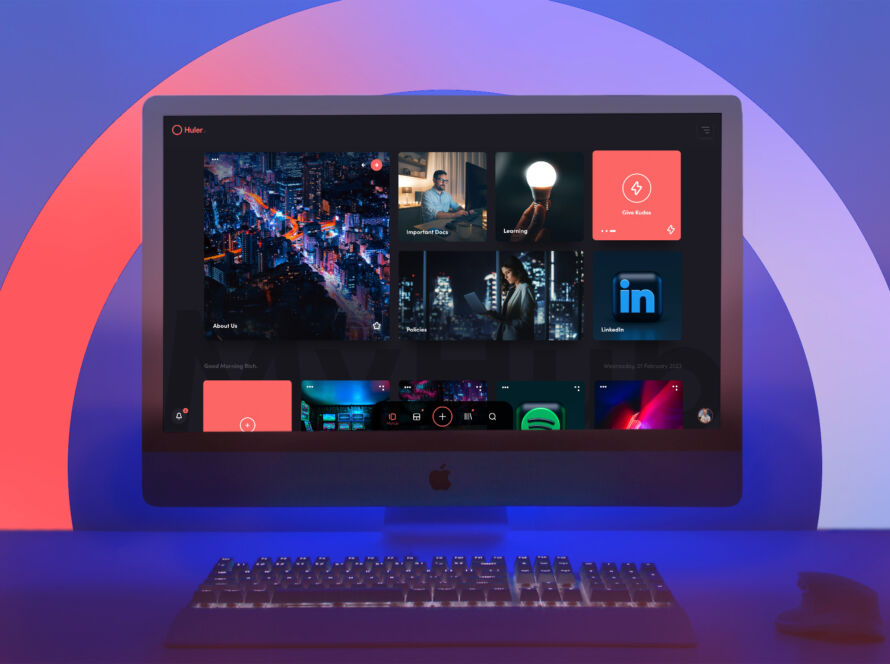Company culture is another one of those buzzwords that often gets thrown around when we talk about employee engagement and experience. But if you ask Google (or your preferred search engine) what company culture actually means; it seems the jury is out on a definitive definition.
The Balance Careers blog offers this explanation:
“Company culture refers to the attitudes and behaviours of a company and its employees. It is evident in the way an organization’s people interact with each other, the values they hold, and the decisions they make.”
While SHRM’s Understanding and Developing Organizational Culture toolkit explains that:
“Culture is a nebulous concept and is often an undefined aspect of an organization. Although extensive academic literature exists relating to the topic…there is no generally accepted definition of culture. Instead, the literature expresses many different views as to what organizational culture is.”
It’s little wonder that some organisations find it difficult to define their own company culture, when what that actually means constantly changes depending on who you ask!
Defining Company Culture
The reason why defining company culture is difficult is because it varies widely between different countries, cultures, sectors, and leaders. And that’s probably why many organisations struggle to pin down their own company cultures too.
We all know what opinions are like…don’t make us say it. But essentially, everyone has an opinion of what culture is. And when those ideas don’t align in some way, shape or form, it can drag the whole thing system down.
Since workplace culture is so subjective, perhaps it is more productive to focus on the signs of a great company culture.
Sound good? Let’s do it then!
13 Signs Of A Great Company Culture
High Employee Retention
Staff turnover is a great indication of company culture. According to an article by Best Money Moves, the top 10 reasons why employees leave their jobs are:
- Unsatisfactory pay
- Stress or an unmanageable workload
- No advancement opportunities
- Employer’s values not aligning with their own
- Interest in a different industry or career path
- Poor work/life balance
- Unsatisfactory benefits
- Lack of employee recognition
- Concerns about their employer’s ability to address health and safety concerns in the wake of COVID-19
- No options for remote work
Reasons given under the option of ‘other’ also included toxic work environments, long commutes, retirement, unreasonable expectations, relocation and disorganised management teams.
While some reasons for an employee leaving are totally out of your control (e.g. relocation or retirement), at least 90% of the reasons listed above are related to company culture.
When employees are paid fairly, given the right tools to manage their workload, encouraged to strike a better work-life balance, offered opportunities for development and recognised for their work, they’ll stick around. Simple, right?
Regular and Transparent Communications
Regular, honest and transparent two-way communications are vital for a great company culture.
If we believe our corporate cultures are a set of shared values and attitudes, it’s impossible to inform people of this and help them connect with it without effective communication.
However, data from Gallup tells us that only 13% of employees strongly agree that the leaders in their organisations communicate effectively.
Uncertainty, secrecy and inconsistent communications don’t make anyone feel good. How can an employee connect and align themselves with your company’s core values and goals if they don’t know what they are? How do team members know they are doing a good job if nobody tells them?
No one likes to be kept in the dark. Which is why companies with effective internal communications strategies that strive to inspire, inform, teach, drive action, and collaborate inevitably fare better in the culture stakes than those who don’t.
A Diverse Workforce
Cultivating different skills, perspectives, passions, insights, and personalities can open the door to more creativity and innovation – putting your business at a competitive advantage to those with workforces made up of the same demographic.
Take the world’s largest PC vendor, Lenovo, as an example. The organisation has built its success on a strong foundation of diversity and inclusion, which results in the company coming up with a number of cutting-edge ideas year on year. This notion is nicely summed up by Lenovo’s Chief Diversity Officer, Yolanda Conyers, who writes on the companies Diversity page:
“It takes every dimension of our diversity. All our diverse mindsets, skills, and cultural backgrounds, to deliver such a wide array of technology…”
Regular Employee Recognition
Employee recognition is a culture in and of itself. Seeing, recognising, appreciating and rewarding the hard work of your teams not only helps organisations retain top talent but increases employee engagement and encourages continued high performance.
In a recent employee engagement survey that included the question, “What is the most important thing that your manager or company currently does that would cause you to produce great work?”, 37% of respondents said recognition.
There’s no other way we can say it: employees want to be recognised for the good work they do – and not just financially either.
Ongoing Professional Development
Some global brands are well known for their ‘churn and burn’ workplace cultures driven by impossibly high standards, fear, poor communication, inflexibility and below par working conditions.
Thankfully however, in recent years more businesses have realised that showing empathy, mutual respect, humanity and actively investing in their employees pays dividends in the long-term.
Cultures of continuous learning, where employees are encouraged to learn new skills and innovate across an organisation, form part of this approach. And it’s also super important to the future of many organisations as technology disrupts the way they work and increases the need for new solutions and creative approaches.
A great workplace culture recognises this and strives to present employees with ongoing professional development that’s not only relevant to their roles and passions but the future of the business, too.
A Clear Vision And Values
In a previous article here on our blog, we reflected on what is important to millennials in the workplace. In it, we found that millennials crave a sense of purpose and to be part of something bigger than themselves.
Without a clear vision and set values, an organisation cannot build an effective culture. Nor can it identify talent that is aligned with those values and committed to working towards the overarching mission.
Your mission statement, vision and core values aren’t just for your customers. Neither are they just an opportunity to create an inspirational graphic for the walls of your office. They are the glue that holds your roadmap together and they guide employees to bring their best selves to work every single day.
Employee Benefits
We were loathed to put this one in because, in our opinion many organisations the world over have supplemented their own workplace culture with generic benefits that do nothing to enhance the employee experience (we see you over there with your ‘free tea and coffee’).
However, benefits actually do signal a great corporate culture when they are done right. We can all agree that having a ping pong table in the office doesn’t actually tell us anything about a company’s culture. Instead, benefits need to align with those core values we talked about earlier.
In a 2019 survey, Aviva discovered that the 10 benefits people want most are:
- 22-35 days of paid annual leave
- Pension scheme
- Flexible work hours (including working from home)
- Paid sick leave and/or critical illness cover
- Bonuses and/or profit and share options
- Training and career development
- Health and/or life insurance
- Unlimited paid annual leave
- Free meals and/or drinks
- Eye tests and/or dental
A further deep dive on this survey also uncovers that only 4% of respondents wanted entertainment at work and (perhaps most surprisingly) only 1 in 20 employees wanted dogs in the office. Sorry, doggos!
Employees also reported that they would like to see new benefits in the form of wellness allowances, duvet days, and interest-free loans for things like home improvements or weddings.
So it’s fair to say most employers are wide of the mark when it comes to giving employees what they want. While free food and drink has its place, it’s clear that benefits which help employees preserve their mental health and wellbeing, develop their skills, and have more flexibility fair outweigh the siren song of a fancy coffee machine.
Positive Working Relationships
We’ve all heard how devastating toxic working relationships can be for people’s mental health and wellbeing. Truth is (and this might sound controversial coming from a work tech blog) no job is worth sacrificing your peace of mind or mental health for.
One of the biggest signs of a great workplace culture are positive relationships and interactions. These can range from the basics (like saying “Good Morning” to your colleagues) to the boundaries and expectations we have of one another.
Positive working relationships flourish because they are founded on a base of mutual respect and understanding. While you can’t ever expect a team of diverse individuals to all become besties for life, if your company culture is one that is supportive, respectful, and understanding – with clear processes in place to facilitate productive work – then employees will work together better and interact positively because it is mutually beneficial for them to do so. And it just feels nice!
More Innovation
In an article by technology chief Waguih Ishak in McKinsey Quarterly he writes that:
“As an innovation leader, you must ground creative people in accountability for the organization’s objectives, key focus areas, core capabilities, and commitments to stakeholders. Then you give them broad discretion to conduct their work in service of those parameters.”
For organisations to foster a sense of innovation, their culture must back up the overarching mission and then give employees the freedom to apply their expertise in pursuit of these goals.
If leaders don’t trust their workforce to work autonomously towards a common goal, they can’t expect innovation from them. A culture built on trust that empowers employees, however, is one that encourages and incites innovation.
Accessible Leadership Teams
In recent years, what makes a good leader has changed. Where once upon a time leaders were revered (and sometimes feared), now approachability and accessibility are key.
In her article exploring the concept of leadership accessibility, coach and author Coleen Seward Ryan defines two ways of being an accessible leader: active leadership accessibility and passive leadership accessibility.
Active accessibility leaders ‘seek out [their] employees, engaging them in conversations and learning about what’s going on.’
Passive leadership accessibility often comes in the form of an “open door policy” that encourages employees to seek out leaders with concerns or questions.
Of course, there are boundaries to consider as the time of leaders is not infinite. However, having your ear to the ground and being open to suggestions, questions and ideas creates an open, employee-driven culture that makes your people feel valued and appreciated.
A Healthy Approach To Wellbeing
More leaders are starting to understand that their employees don’t leave their mental health at the door when they’re at work and more needs to be done to support them.
Great company cultures revolve around creating a supportive and psychologically safe environment for employees. This can be achieved through the implementation of employee assistance programmes, mental health and wellbeing training, and flexible working arrangements – to name a few.
In 2021, we saw more global organisations take even further action to combat burnout. In June, the dating app Bumble temporarily closed all of its offices for a week and told their 700 members of staff to switch off and focus on themselves. Tech firm Mozilla also followed suit a month later, shutting down the entire company for a “Wellness Week,” a move that dovetailed with their decision to introduce companywide “Wellness Days” once a month, every month, for 2021.
In fact, a huge number of Fortune500 companies are moving to offer increased paid time off that gives employees the space to prioritise their mental and physical health.

Less Blame and More Accountability
Cultures of blame breed cultures of fear. And when your people are fearful, they are less likely to take risks or try new things because they want to avoid getting told off (or worse). A culture of accountability, however, changes the game entirely.
While powerful, accountability starts at the top. If a business is enforcing a certain level of expectation, it should apply to everyone and leaders should set an example by owning their mistakes and taking responsibility for their actions.
When this trickles down in a workplace culture and employees are equipped with a growth-mindset, there’s less finger pointing. Instead, everyone works together to find solutions to problems and forge ahead toward a common goal. What’s more, they aren’t afraid to fail fast and learn quickly, making room for heaps more innovation and creativity in the long-term.
Empowered Employees
Our last sign of a great workplace culture is empowered employees. When your people are kept in the loop, comfortable sharing their ideas, and have a good work-life balance, they are able to work with more autonomy and take responsibility for their own work day.
We don’t need to tell you the benefits an organisation stands to reap from an empowered workforce. Not only are they happier, they are more engaged, committed, productive, motivated and hungry to succeed. They are also more likely to apply their passion to projects that could be lucrative for your business. What’s not to like about that?!

Cultivating A Great Company Culture
So there you have it, our 13 signs of a great company culture. If you want all of this (and more!) for your own business, then you’ve come to the right place. At Huler, we are really passionate about helping businesses improve their employee experience, embrace hybrid working, boost engagement and utilise technology to bring about more innovation and creativity in their business.
We do this by creating intuitive, people-first digital workplace platforms that help organisations communicate their culture at key points throughout the employee journey, from onboarding processes and continuous professional development to support with health and wellbeing, breaking down workplace silos and much more.
To learn more about what we do, take a look at HulerHub. Alternatively, book a demo to see how HulerHub can support your culture.




